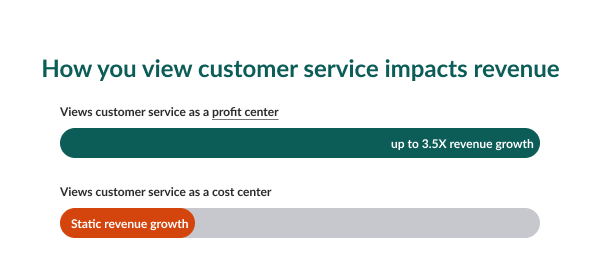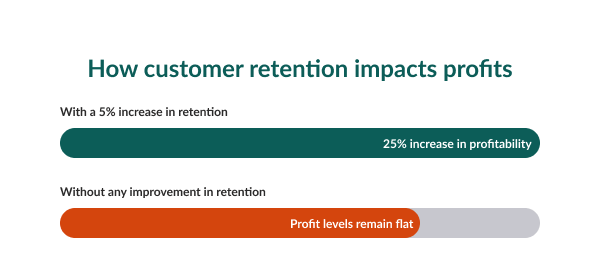Customer-centric companies can generate up to 80% more revenue than competitors who are less customer focused.
In addition, companies that view customer service as a profit center rather than a cost center experience 3.5X more revenue growth than those that don’t.
So why do many business leaders still believe that customer service teams are a cost to the company – rather than the secret to sustainable revenue growth?

In this article, we share how customer service teams can help you generate more revenue in your business – profitably – and the steps you can take to support them.
But before discussing the details, let’s examine what a cost center is and what your customer service teams should be doing for your business.
Cost center vs. profit center
It’s important to understand the difference between profit centers and cost centers.
A cost center is a necessary expense incurred while operating your business that doesn’t directly produce revenue. It’s something your accountants would classify as a cost.
Software developers are an example of a cost center in a B2B SaaS company. They are essential to making the product but don’t contribute directly to business profitability.
On the flip side, a profit center is a part of the business that is expected to add revenue to a company’s bottom line.
The clearest example of a profit center in a B2B SaaS company – or in any other business, for that matter – is the sales team. Their job is focused on generating new revenue.
But where does customer service sit in the profit vs. cost debate?
To help you understand why we believe customer service teams are profit centers and not cost centers, let’s look at the role of customer service teams in business.
Customer service teams in context
Customer service is a broad term.
But if we break customer service down into the teams and activities that feed into it, it’ll soon become clear exactly how much of your business is focused on it.
Typical areas that fall under the customer service umbrella include:
- Customer Support
- Customer Success
- Account Management
- Onboarding / Implementation
- Contact Centers
Together, they are responsible for activities that help deliver value to your customers through your products or services. These include:
- Answering customer questions
- Giving advice and consultancy
- Helping customers get value from your products
- Acting as a point of contact
- Discussing customer accounts and usage rates
Now, how can customer service teams contribute to your company’s bottom line and help you increase revenue?
How customer service teams can help you grow revenue
Business leaders recognize that focusing on customers and providing them with first-class service is the key to long-term sustainable revenue growth.
To achieve this, you need to let go of the stereotypical poor experiences that many of us have received in the past, such as:
- Slow response times / long wait times
- Poor quality responses
- Passive approach to customer issues
- Bouncing customers around different teams to get the right answer
- Treating the customer as an inconvenience
Customer-centric service teams look at their approach to customers differently and concentrate on trying to deliver best-in-class experiences, using techniques like:
- Quick response times and short waiting times
- High-quality responses, solving issues on first contact
- Being proactive about helping customers get value from your product
- Taking responsibility and resolving customer issues directly
- Treating customers like valued partners and forming ongoing relationships
In addition, customer service teams are also looking for ways to grow revenue from their existing customers.
After all, an existing customer is 60-70% more likely to buy from your company than a new prospect.

But what steps can customer service teams take to monetize their relationships with customers and contribute to the revenue growth of your business?
4 ways customer service teams can contribute to revenue growth
Here are four approaches you can use today to turn your customer service teams into profit centers rather than cost centers.
1. Account expansion
Many companies sign up new customers with the goal of increasing their accounts' lifetime value (LTV) over time.
The initial adoption phase of a new customer is about getting used to your product and ensuring it provides value to them – providing a platform for future growth.
This phase also gives your customer service teams the opportunity to build better relationships with your customers and monitor their progress.
Then, when the time is right, you can talk with your customers about natural growth in their accounts. Catalysts for this natural growth can include:
- Business growth – needing more of what you offer to meet their demand
- Team growth – more new team members need access to your product/service
- Expansion into other departments – more people are adopting your product
- Strategic expansion – e.g., opening new offices, sites, or locations
Opportunities to discuss account expansion with your customers can happen at any point in your relationship with them, but they most commonly occur during:
- Renewal discussions: “This year, we’ll need 50 extra licenses.”
- Account reviews / QBRs: “We aim to grow our headcount over the next quarter.”
- Strategic outreach: “Usage patterns suggest you may need more licenses.”
- Support interactions: “I want to talk about pricing and adding more team members.”
All this means you should be training your customer service team to recognize these opportunities and have the appropriate processes in place to capitalize on them.
Any member of your team working under the “customer service” umbrella should be empowered to start these conversations with customers confidently and comfortably.
Your processes should help them complete or escalate these requests accordingly while maintaining a seamless customer experience.
Of course, natural account expansion is not the only way that customer service teams can help generate revenue and become a profit center – they can also initiate upsells.
2. Upselling
Upselling is known to increase revenue by 10-30%. That’s why it’s an essential part of most companies' revenue generation mix.

Upsells differ from account expansion in that they don’t seek to capture natural growth but instead focus on selling a higher-priced option or product add-on.
Examples of upsells that you might encounter when selling more to existing B2B customers include:
- Adding on an enhanced product support service package
- Moving a customer from one pricing tier to another
- Increasing the number of features your customer can access
Because of their proximity to your customers, your service teams are perfectly placed to initiate upsells and contribute towards overall revenue growth.
To foster a culture of successful upselling among your customer service teams, you can take some key steps to maximize your chances of success.
Incentives - A surefire way to encourage your customer service teams to engage in upselling is to incentivize them through commissions, bonuses, and prizes. This can be scaled depending on your specific circumstances. Typically, as a rule of thumb: the harder to do the upsell or the more lucrative it is, the higher the incentive you should offer.
Process – To ensure upsell increase without alienating your customers, you need to have appropriate processes in place. These processes will help your teams understand when to offer an upsell, which teams should offer it, how to add it to a customer’s account, etc.
Training – Some people who work in customer service love to help customers but shy away from sales. To help them overcome this, you should train your staff in upsells. Such training should include real-world scenarios of when to include an upsell in a customer conversation, thus helping them grow confidence and sales skills.
Iterative improvement – Of course, no major change in business practices will be perfect from day one. So, you should take time to make improvements over time. By measuring what is working, listening to feedback, and being agile with processes and upsell tactics, you can iterate how you use upsells for maximum success.
Once your customer service team has mastered upsells, you can consider using cross-sells as another way to move them from a cost center into a revenue generator.
3. Cross-selling
According to research by McKinsey, cross-selling can increase revenue by 20% and increase profitability by 30%.
This is because your existing customers are somewhat of a captive market and are up to 70% more likely to buy from your business.

Cross-selling is the art of selling a different product or service to an existing customer. This contrasts with upselling, which is all about adding to existing products.
When it comes to B2B cross-selling, some examples in SaaS that might help inspire you include:
- An email marketing platform that also offers an advertising platform to help you promote your newsletter in your target demographic.
- A sales intelligence tool that provides contact data and offers a cold email service to help you generate leads.
- A live chat product that also offers a ticket helpdesk solution to help you offer multi-channel customer service at scale.
Aside from the increase in revenue and profitability, cross-sells offer companies a number of benefits:
- The chance to improve customer satisfaction
- An increase in customer lifetime value (CLV)
- The ability to make your company’s solutions more deeply embedded and “sticky”
And when it comes to implementing a cross-selling strategy, it’s similar to implementing an upsell strategy.
It’s about creating an environment that encourages and rewards cross-sells and ensuring your team is fully equipped to maximize the opportunity.
Some approaches you can take to ensure that cross-sells become a key part of your customer service teams’ revenue generation strategy include:
Giving them the right tools and processes – If your customer service teams have a full 360° view of your customer’s history with your company, they will be able to easily see which cross-sell opportunities will resonate most.
Tools like a CRM platform covering the full customer journey are ideal for this.
Combining the right tools with well-defined processes will empower your teams to deliver cross-selling success at scale.
Empowering your teams – It’s critical to give your teams the training they need to be comfortable executing a cross-sell strategy and to give them “free reign” to close deals themselves.
Without it, your teams will feel ill-equipped to promote cross-sell opportunities to the best of their ability and constrained by micro-management that doesn’t trust them to deliver!
Incentivizing success – As with all things sales-related, if your employees’ actions directly impact your company's revenue, they should be rewarded appropriately.
Think carefully about how you implement this, though.
If you want your customer service teams to be quota-driven and close deals like a pure sales team, you can expect to pay health commissions on all cross-sells they win.
Depending on the size and scale of the sales deals, you may prefer to reward lead generation for cross-sells and offer targets and bonuses linked to performance instead.
Deciding which path you choose depends on the sales capability of your customer services teams and the size of the cross-sell deals that are likely to occur.
How you do it is up to you, but it's not uncommon for customer success teams to have revenue and retention targets, so don’t underestimate what can be achieved.
However, cross-selling, upselling, and account expansion aren’t the only ways your customer service team can contribute to revenue and avoid becoming classified as a cost.
When it comes to business success, revenue retention is just as important as revenue generation.
4. Revenue retention
It costs your business more money to acquire a new customer than it does to retain an existing customer.
In fact, Forrester found that a 5% uplift in retention can lead to a 25% increase in profitability.
This means that your customer service teams should focus on retaining customers to protect the revenue you already have and use it as a springboard for further growth.

Retention should be at the top of all customer service teams' minds, but teams like customer success have been specifically created to champion it.
Key actions your customer service teams can take to help retain customers include:
- Look at usage patterns. Are customers using your product? If not, reach out!
- Pay close attention to customers complaining about your product
- Don’t just meet customer expectations – try to exceed them
- Form better relationships with your customers and always do your best for them
By working to retain customers and actively engaging with them, your customer service teams are not only doing their job, but they’re also positively affecting revenue.
That said, your customer service team will need the right tools to boost revenue, capture natural account growth, or focus on upsells and cross-sells.
The right tools, like SuperOffice’s CRM platform, for example.
How a CRM platform can help your customer services teams generate revenue
At SuperOffice, we believe that building high-quality, authentic customer relationships is the key to unlocking sustained business growth and long-term success.
Your customer service teams are better placed than anyone else in your company to build ongoing relationships with your customers.
However, they need the right tools to build the kinds of relationships that lead to revenue growth and turn customer service teams into profit centers.
CRM software - like SuperOffice - enables you to manage your entire customer relationship across marketing, sales, and service from one easy-to-use, award-winning platform.
SuperOffice Service includes a full range of features that’ll set your customer service teams up for success, including:
- Multi-channel support helpdesk to help your customers wherever they’re at
- Inbuilt AI assistance to help you scale your support offering to new heights
- A complete record of your entire customer history – no silos, just a 360° view
- Ticket management, live chat, and automation options as standard
- Robust reporting and dashboards to help you track progress
- And much more…
Ready to turn your customer services team into a revenue-generating profit center?
Book a demo of SuperOffice today and learn how your sales, marketing, and service teams can all generate revenue from one CRM platform.



